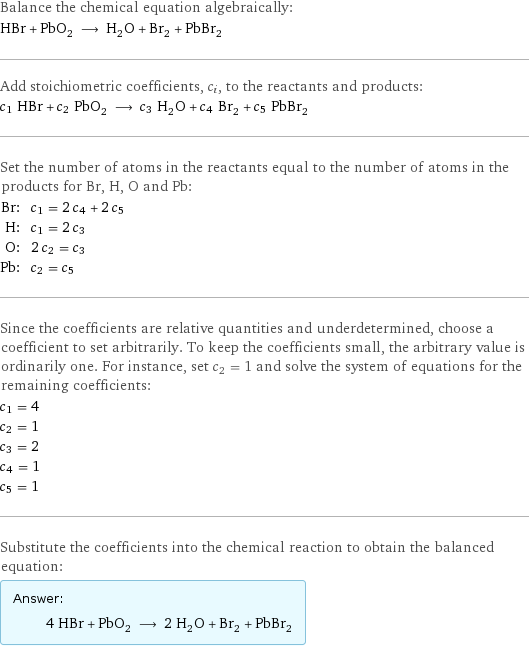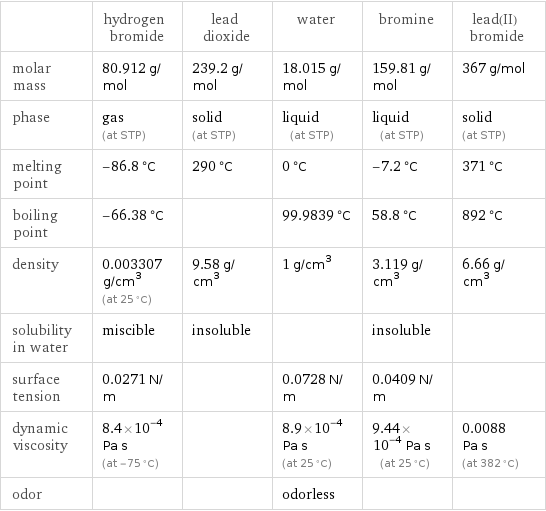Input interpretation

HBr hydrogen bromide + PbO_2 lead dioxide ⟶ H_2O water + Br_2 bromine + PbBr_2 lead(II) bromide
Balanced equation

Balance the chemical equation algebraically: HBr + PbO_2 ⟶ H_2O + Br_2 + PbBr_2 Add stoichiometric coefficients, c_i, to the reactants and products: c_1 HBr + c_2 PbO_2 ⟶ c_3 H_2O + c_4 Br_2 + c_5 PbBr_2 Set the number of atoms in the reactants equal to the number of atoms in the products for Br, H, O and Pb: Br: | c_1 = 2 c_4 + 2 c_5 H: | c_1 = 2 c_3 O: | 2 c_2 = c_3 Pb: | c_2 = c_5 Since the coefficients are relative quantities and underdetermined, choose a coefficient to set arbitrarily. To keep the coefficients small, the arbitrary value is ordinarily one. For instance, set c_2 = 1 and solve the system of equations for the remaining coefficients: c_1 = 4 c_2 = 1 c_3 = 2 c_4 = 1 c_5 = 1 Substitute the coefficients into the chemical reaction to obtain the balanced equation: Answer: | | 4 HBr + PbO_2 ⟶ 2 H_2O + Br_2 + PbBr_2
Structures

+ ⟶ + +
Names

hydrogen bromide + lead dioxide ⟶ water + bromine + lead(II) bromide
Reaction thermodynamics
Enthalpy

| hydrogen bromide | lead dioxide | water | bromine | lead(II) bromide molecular enthalpy | -36.3 kJ/mol | -277.4 kJ/mol | -285.8 kJ/mol | 0 kJ/mol | -278.7 kJ/mol total enthalpy | -145.2 kJ/mol | -277.4 kJ/mol | -571.7 kJ/mol | 0 kJ/mol | -278.7 kJ/mol | H_initial = -422.6 kJ/mol | | H_final = -850.4 kJ/mol | | ΔH_rxn^0 | -850.4 kJ/mol - -422.6 kJ/mol = -427.8 kJ/mol (exothermic) | | | |
Gibbs free energy

| hydrogen bromide | lead dioxide | water | bromine | lead(II) bromide molecular free energy | -53.4 kJ/mol | -217.3 kJ/mol | -237.1 kJ/mol | 0 kJ/mol | -261.9 kJ/mol total free energy | -213.6 kJ/mol | -217.3 kJ/mol | -474.2 kJ/mol | 0 kJ/mol | -261.9 kJ/mol | G_initial = -430.9 kJ/mol | | G_final = -736.1 kJ/mol | | ΔG_rxn^0 | -736.1 kJ/mol - -430.9 kJ/mol = -305.2 kJ/mol (exergonic) | | | |
Equilibrium constant
![Construct the equilibrium constant, K, expression for: HBr + PbO_2 ⟶ H_2O + Br_2 + PbBr_2 Plan: • Balance the chemical equation. • Determine the stoichiometric numbers. • Assemble the activity expression for each chemical species. • Use the activity expressions to build the equilibrium constant expression. Write the balanced chemical equation: 4 HBr + PbO_2 ⟶ 2 H_2O + Br_2 + PbBr_2 Assign stoichiometric numbers, ν_i, using the stoichiometric coefficients, c_i, from the balanced chemical equation in the following manner: ν_i = -c_i for reactants and ν_i = c_i for products: chemical species | c_i | ν_i HBr | 4 | -4 PbO_2 | 1 | -1 H_2O | 2 | 2 Br_2 | 1 | 1 PbBr_2 | 1 | 1 Assemble the activity expressions accounting for the state of matter and ν_i: chemical species | c_i | ν_i | activity expression HBr | 4 | -4 | ([HBr])^(-4) PbO_2 | 1 | -1 | ([PbO2])^(-1) H_2O | 2 | 2 | ([H2O])^2 Br_2 | 1 | 1 | [Br2] PbBr_2 | 1 | 1 | [PbBr2] The equilibrium constant symbol in the concentration basis is: K_c Mulitply the activity expressions to arrive at the K_c expression: Answer: | | K_c = ([HBr])^(-4) ([PbO2])^(-1) ([H2O])^2 [Br2] [PbBr2] = (([H2O])^2 [Br2] [PbBr2])/(([HBr])^4 [PbO2])](../image_source/29931bb34105242bf70458187750917a.png)
Construct the equilibrium constant, K, expression for: HBr + PbO_2 ⟶ H_2O + Br_2 + PbBr_2 Plan: • Balance the chemical equation. • Determine the stoichiometric numbers. • Assemble the activity expression for each chemical species. • Use the activity expressions to build the equilibrium constant expression. Write the balanced chemical equation: 4 HBr + PbO_2 ⟶ 2 H_2O + Br_2 + PbBr_2 Assign stoichiometric numbers, ν_i, using the stoichiometric coefficients, c_i, from the balanced chemical equation in the following manner: ν_i = -c_i for reactants and ν_i = c_i for products: chemical species | c_i | ν_i HBr | 4 | -4 PbO_2 | 1 | -1 H_2O | 2 | 2 Br_2 | 1 | 1 PbBr_2 | 1 | 1 Assemble the activity expressions accounting for the state of matter and ν_i: chemical species | c_i | ν_i | activity expression HBr | 4 | -4 | ([HBr])^(-4) PbO_2 | 1 | -1 | ([PbO2])^(-1) H_2O | 2 | 2 | ([H2O])^2 Br_2 | 1 | 1 | [Br2] PbBr_2 | 1 | 1 | [PbBr2] The equilibrium constant symbol in the concentration basis is: K_c Mulitply the activity expressions to arrive at the K_c expression: Answer: | | K_c = ([HBr])^(-4) ([PbO2])^(-1) ([H2O])^2 [Br2] [PbBr2] = (([H2O])^2 [Br2] [PbBr2])/(([HBr])^4 [PbO2])
Rate of reaction
![Construct the rate of reaction expression for: HBr + PbO_2 ⟶ H_2O + Br_2 + PbBr_2 Plan: • Balance the chemical equation. • Determine the stoichiometric numbers. • Assemble the rate term for each chemical species. • Write the rate of reaction expression. Write the balanced chemical equation: 4 HBr + PbO_2 ⟶ 2 H_2O + Br_2 + PbBr_2 Assign stoichiometric numbers, ν_i, using the stoichiometric coefficients, c_i, from the balanced chemical equation in the following manner: ν_i = -c_i for reactants and ν_i = c_i for products: chemical species | c_i | ν_i HBr | 4 | -4 PbO_2 | 1 | -1 H_2O | 2 | 2 Br_2 | 1 | 1 PbBr_2 | 1 | 1 The rate term for each chemical species, B_i, is 1/ν_i(Δ[B_i])/(Δt) where [B_i] is the amount concentration and t is time: chemical species | c_i | ν_i | rate term HBr | 4 | -4 | -1/4 (Δ[HBr])/(Δt) PbO_2 | 1 | -1 | -(Δ[PbO2])/(Δt) H_2O | 2 | 2 | 1/2 (Δ[H2O])/(Δt) Br_2 | 1 | 1 | (Δ[Br2])/(Δt) PbBr_2 | 1 | 1 | (Δ[PbBr2])/(Δt) (for infinitesimal rate of change, replace Δ with d) Set the rate terms equal to each other to arrive at the rate expression: Answer: | | rate = -1/4 (Δ[HBr])/(Δt) = -(Δ[PbO2])/(Δt) = 1/2 (Δ[H2O])/(Δt) = (Δ[Br2])/(Δt) = (Δ[PbBr2])/(Δt) (assuming constant volume and no accumulation of intermediates or side products)](../image_source/aff673a0f2a34e2ac00f2a9aabdea1c5.png)
Construct the rate of reaction expression for: HBr + PbO_2 ⟶ H_2O + Br_2 + PbBr_2 Plan: • Balance the chemical equation. • Determine the stoichiometric numbers. • Assemble the rate term for each chemical species. • Write the rate of reaction expression. Write the balanced chemical equation: 4 HBr + PbO_2 ⟶ 2 H_2O + Br_2 + PbBr_2 Assign stoichiometric numbers, ν_i, using the stoichiometric coefficients, c_i, from the balanced chemical equation in the following manner: ν_i = -c_i for reactants and ν_i = c_i for products: chemical species | c_i | ν_i HBr | 4 | -4 PbO_2 | 1 | -1 H_2O | 2 | 2 Br_2 | 1 | 1 PbBr_2 | 1 | 1 The rate term for each chemical species, B_i, is 1/ν_i(Δ[B_i])/(Δt) where [B_i] is the amount concentration and t is time: chemical species | c_i | ν_i | rate term HBr | 4 | -4 | -1/4 (Δ[HBr])/(Δt) PbO_2 | 1 | -1 | -(Δ[PbO2])/(Δt) H_2O | 2 | 2 | 1/2 (Δ[H2O])/(Δt) Br_2 | 1 | 1 | (Δ[Br2])/(Δt) PbBr_2 | 1 | 1 | (Δ[PbBr2])/(Δt) (for infinitesimal rate of change, replace Δ with d) Set the rate terms equal to each other to arrive at the rate expression: Answer: | | rate = -1/4 (Δ[HBr])/(Δt) = -(Δ[PbO2])/(Δt) = 1/2 (Δ[H2O])/(Δt) = (Δ[Br2])/(Δt) = (Δ[PbBr2])/(Δt) (assuming constant volume and no accumulation of intermediates or side products)
Chemical names and formulas

| hydrogen bromide | lead dioxide | water | bromine | lead(II) bromide formula | HBr | PbO_2 | H_2O | Br_2 | PbBr_2 Hill formula | BrH | O_2Pb | H_2O | Br_2 | Br_2Pb name | hydrogen bromide | lead dioxide | water | bromine | lead(II) bromide IUPAC name | hydrogen bromide | | water | molecular bromine |
Substance properties

| hydrogen bromide | lead dioxide | water | bromine | lead(II) bromide molar mass | 80.912 g/mol | 239.2 g/mol | 18.015 g/mol | 159.81 g/mol | 367 g/mol phase | gas (at STP) | solid (at STP) | liquid (at STP) | liquid (at STP) | solid (at STP) melting point | -86.8 °C | 290 °C | 0 °C | -7.2 °C | 371 °C boiling point | -66.38 °C | | 99.9839 °C | 58.8 °C | 892 °C density | 0.003307 g/cm^3 (at 25 °C) | 9.58 g/cm^3 | 1 g/cm^3 | 3.119 g/cm^3 | 6.66 g/cm^3 solubility in water | miscible | insoluble | | insoluble | surface tension | 0.0271 N/m | | 0.0728 N/m | 0.0409 N/m | dynamic viscosity | 8.4×10^-4 Pa s (at -75 °C) | | 8.9×10^-4 Pa s (at 25 °C) | 9.44×10^-4 Pa s (at 25 °C) | 0.0088 Pa s (at 382 °C) odor | | | odorless | |
Units
